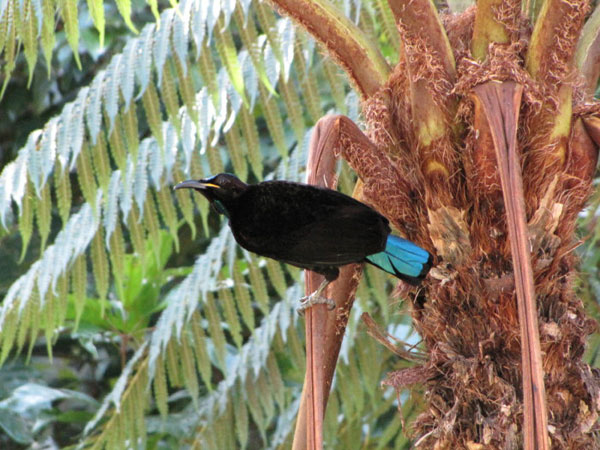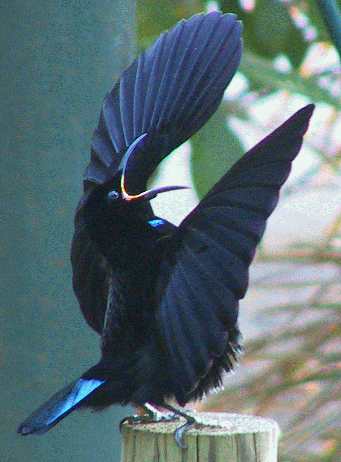Paradise Riflebird Biography
Victoria 's Riflebird, Ptiloris victoriaea, is smaller (23 cm - 25 cm) and occurs only in north-eastern Queensland








The Paradise Riflebird is a medium-sized, long-billed riflebird without plumes. The adult male is velvety black with a metallic oil-green sheen to crown, nape and upper breast shield. The tail is very short with iridescent (shining) blue-green central tail feathers. The remainder of under parts are velvety black with the tips of feathers an iridescent dark green. The bill long and curves strongly downwards. The female and immature have greyish-brown upperparts, rufous on the wings, a whitish eyebrow and throat. The underparts are buff with black 'horseshoe' markings.
The Paradise Riflebird occurs in highland rainforests of the Great Dividing Range from central-eastern New South Wales north of Dungog to the Bunya Mountains , south-eastern Queensland Calliope Range , east of Biloela , Queensland
The Paradise Riflebird is found in subtropical and temperate rainforests (including Antarctic Beech rainforest), mostly in mountains and foothills, and adjoining wetter eucalypt forests
The Paradise Riflebird is an active feeder, foraging like a tree creeper up tree trunks and along branches for insects, spiders and centipedes. The long curved bill is used to pry off large pieces of bark, to chisel into dead branches and to probe into crevices and rotten logs and stumps on the forest floor. They also feed on fruit and often feed together with other fruit eaters such as bowerbirds.
During the breeding season, the gloriously plumaged male Paradise Riflebirds are vocal and conspicuous, spending most of the day on their display perches, which consist of one or more thick, horizontal branches high above the ground in a tall tree. They can be found both by their harsh calls in and around their display areas or by their rustling flight. Their display is spectacular, with the plumage sparkling green, blue or purple in the sunlight. The wings are fully extended and fanned upwards, and the head is thrown backwards to show the metallic, slightly erectile feathers on its throat, while the broad plumes of the belly and flanks are thrown slightly outwards in a circle. The adult females are very cryptic (hard to see) and their nests are not often found. The female alone attends to the nest which is a bulky, rough bowl of twigs, leaves, decorated with moss, orchids, sometimes snakeskin’s, placed high in dense foliage. The males are promiscuous, mating with many females.
Paradise Riflebird

Paradise Riflebird

Paradise Riflebird

Paradise Riflebird

Paradise Riflebird

Paradise Riflebird

Paradise Riflebird

Paradise Riflebird

Paradise Riflebird
Paradise Riflebird
Riflebird Of Paradise -- National Geographic
No comments:
Post a Comment